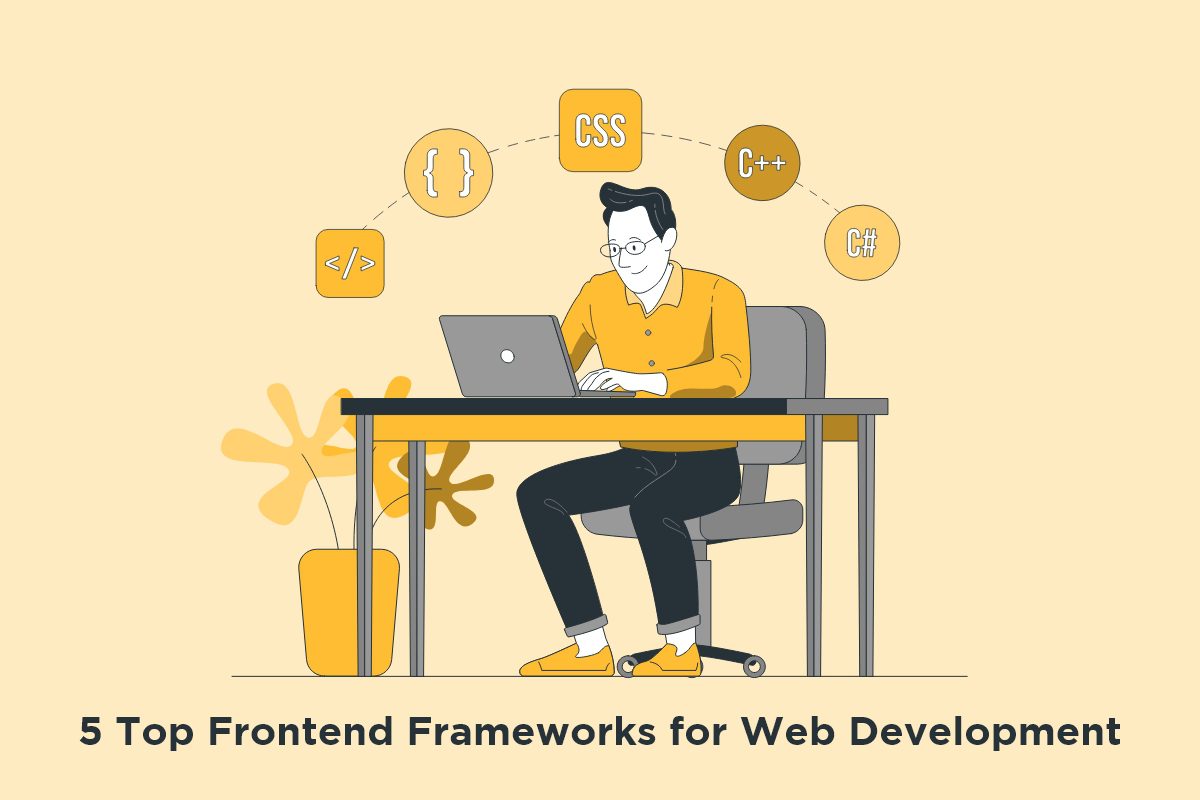Frontend Frameworks’ Role in Web Development

First, let’s define what frontend frameworks are. The term “frontend” refers to the components of an application or website that are visible to users. Typography, colour palettes, button shapes and other design elements all contribute to a graphical user interface that displays data from backend components.
A framework, on the other hand, is a piece of software that facilitates the creation of a certain IT project by offering ready-to-use code on which developers or a web development company can build. As a result, they can avoid starting from scratch and streamline the entire software development process.
As such, a frontend framework is a technology that aids in the development of a web application’s frontend features. It can typically help with the administration of AJAX calls, correlating data with DOM elements and styling app components.
Aspects Influencing Frontend Framework Selection
Before we identify the most popular frontend frameworks, let’s look at the elements that frequently influence technology selection:
Popularity
The more well-known the framework you use, the easier it will be to receive community help or hire dedicated web developers who are familiar with it.
Features
Make certain that your selected framework can truly support your project by giving all of the necessary capabilities that facilitate web app development. Check to see if it supports HTTP connectivity, validation, state management and other features.
Flexibility
It’s a good idea to choose a framework with a variety of customisation possibilities to meet your demands and individual project requirements.
Server-side rendering
If you’re creating a website, it’s critical that the frontend framework supports server-side rendering for faster page load times, higher SEO rankings and a better overall user experience.
Future Assistance
When designing a web app for the long term, as is frequently the case, it’s critical to be confident that a particular technology will be supported for years to come. Otherwise, you may have difficulty preserving the finished result later on.
Capabilities for integration
Even if a framework is extremely powerful and adaptable, you may still require the use of additional tools and libraries for your project. As a result, ensure that the framework of choice can easily ease integration operations.
For more assistance in choosing the frontend framework, you may reach out to a well reputed web development company.
Best Frontend Frameworks to Select
React.js
According to a recent study, React.js is the most popular frontend development framework right now. In essence, it is a free and open-source Javascript toolkit that aids in the creation of user interfaces based on UI components. It was built by Facebook in 2011 and is presently maintained by Meta. One of React’s most notable features is the virtual Document Object Model (DOM), which stores and syncs a UI representation with the real DOM. This allows for rapid and easy editing of the virtual version before the changes that are important are updated to the real DOM. This “reconciliation” technique dramatically increases efficiency and results in excellent functionality.
Angular
Angular is another popular UI development framework. It is based on TypeScript and was first released by Google as Angular.js in 2010. The new version is now known as Angular 2+ and if you hire dedicated web developers, they may further assist businesses in migrating from the legacy version to the most recent one. Angular, like React.js, is a free and open-source framework. However, unlike React, it supports two-way binding, which means that any changes made by a developer can be viewed in real-time. Overall, the framework is excellent for creating single and multi-page online applications, as well as mobile solutions.
Vue.js
Vue.js is one of the most basic and straightforward frontend frameworks. Although it is modest in size, it has a virtual DOM, a component-based architecture and two-way data binding. All of these factors contribute to excellent performance and make the process of updating components and tracking changes easier. Despite being more adaptable and “beginner-friendly” than Angular, Vue.js has struggled to garner mainstream acceptance among large organisations. Many large corporations still rely on the tried-and-true Angular or React, but this may soon change if Vue.js continues to gain market dominance.
jQuery
jQuery is one of the oldest frontend frameworks, having been introduced in 2006 and amassing a big tech community since then. It is a library, but it also matches the description of a framework. As a result, many front-end developers still regard it as such. jQuery enables users to change CSS and DOM in order to improve the interactivity and usefulness of a website or application. It also provides simplicity by decreasing JavaScript coding. jQuery was not originally designed to be used to construct mobile apps. Nonetheless, the framework’s most recent version, jQuery Mobile, enables developers to create native mobile applications.
Anime.js
Anime.js is a great library for adding animations to your website or application. A simple API, yet lightweight and powerful, was released in 2019.
Conclusion
Choosing the proper web development technology for your next project might be difficult, but hopefully, the above frontend framework comparison has provided some clarity. At the end of the day, the decision will most likely come down to your engineers’ personal preferences and the specific requirements of the program you’re aiming to construct.
Author Bio:
Arjun Solanki is a Business Growth Strategist at a Leading Software Development Company. He has experience in developing and executing digital strategies for large global brands in a variety of business verticals. Apart from working on a long-lasting relationship with customers and boosting business revenue, he is also interested in sharing my knowledge on various technologies and its influence on businesses through effective blog posts and article writing.








